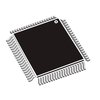Part Details for MC9S08SH16CTLR by Freescale Semiconductor
Results Overview of MC9S08SH16CTLR by Freescale Semiconductor
- Distributor Offerings: (2 listings)
- Number of FFF Equivalents: (0 replacements)
- CAD Models: (Request Part)
- Number of Functional Equivalents: (0 options)
- Part Data Attributes: (Available)
- Reference Designs: (Not Available)
Tip: Data for a part may vary between manufacturers. You can filter for manufacturers on the top of the page next to the part image and part number.
MC9S08SH16CTLR Information
MC9S08SH16CTLR by Freescale Semiconductor is a Microcontroller.
Microcontrollers are under the broader part category of Microcontrollers and Processors.
Microcontrollers (MCUs) are small, low-power integrated circuits used to control embedded systems. Microcontrollers are primarily used to automate and control devices. Read more about Microcontrollers and Processors on our Microcontrollers and Processors part category page.
Price & Stock for MC9S08SH16CTLR
| Part # | Distributor | Description | Stock | Price | Buy | |
|---|---|---|---|---|---|---|
|
|
ComSIT USA | Electronic Component RoHS: Compliant |
|
|
RFQ | |
|
|
Vyrian | Peripheral ICs | 6259 |
|
RFQ |
Part Details for MC9S08SH16CTLR
MC9S08SH16CTLR CAD Models
MC9S08SH16CTLR Part Data Attributes
|
|
MC9S08SH16CTLR
Freescale Semiconductor
Buy Now
Datasheet
|
Compare Parts:
MC9S08SH16CTLR
Freescale Semiconductor
MICROCONTROLLER
|
| Pbfree Code | Yes | |
| Rohs Code | Yes | |
| Part Life Cycle Code | Transferred | |
| Ihs Manufacturer | FREESCALE SEMICONDUCTOR INC | |
| Package Description | TSSOP-28 | |
| Reach Compliance Code | compliant | |
| ECCN Code | EAR99 | |
| HTS Code | 8542.31.00.01 | |
| Has ADC | YES | |
| Address Bus Width | ||
| Bit Size | 8 | |
| Clock Frequency-Max | 40 MHz | |
| DAC Channels | NO | |
| DMA Channels | NO | |
| External Data Bus Width | ||
| JESD-30 Code | R-PDSO-G28 | |
| JESD-609 Code | e3 | |
| Length | 9.7 mm | |
| Moisture Sensitivity Level | 3 | |
| Number of I/O Lines | 24 | |
| Number of Terminals | 28 | |
| On Chip Program ROM Width | 8 | |
| Operating Temperature-Max | 85 °C | |
| Operating Temperature-Min | -40 °C | |
| PWM Channels | YES | |
| Package Body Material | PLASTIC/EPOXY | |
| Package Code | TSSOP | |
| Package Equivalence Code | TSSOP28,.25 | |
| Package Shape | RECTANGULAR | |
| Package Style | SMALL OUTLINE, THIN PROFILE, SHRINK PITCH | |
| Peak Reflow Temperature (Cel) | 260 | |
| Qualification Status | Not Qualified | |
| RAM (bytes) | 1024 | |
| ROM (words) | 16384 | |
| ROM Programmability | FLASH | |
| Screening Level | AEC-Q100 | |
| Seated Height-Max | 1.2 mm | |
| Speed | 40 MHz | |
| Supply Voltage-Max | 5.5 V | |
| Supply Voltage-Min | 2.7 V | |
| Supply Voltage-Nom | 3 V | |
| Surface Mount | YES | |
| Technology | CMOS | |
| Temperature Grade | INDUSTRIAL | |
| Terminal Finish | Matte Tin (Sn) | |
| Terminal Form | GULL WING | |
| Terminal Pitch | 0.65 mm | |
| Terminal Position | DUAL | |
| Time@Peak Reflow Temperature-Max (s) | 40 | |
| Width | 4.4 mm | |
| uPs/uCs/Peripheral ICs Type | MICROCONTROLLER |
MC9S08SH16CTLR Frequently Asked Questions (FAQ)
-
The maximum clock frequency that can be used with the internal oscillator is 16 MHz. However, it's recommended to use a crystal oscillator or an external clock source for more accurate and stable clocking.
-
To configure the watchdog timer, you need to set the WDTCLK register to select the clock source, set the WDTCNT register to set the timeout period, and enable the watchdog timer by setting the WDTEN bit in the WDTCTL register. Make sure to service the watchdog timer regularly to prevent a reset.
-
No, the ADC can only measure voltages between 0V and VDD. If you need to measure voltages above VDD, you'll need to use an external voltage divider or attenuation circuit to bring the voltage within the ADC's input range.
-
The MC9S08SH16CTLR has several low-power modes, including Stop, Wait, and Low-Power Run. To implement a low-power mode, you need to set the appropriate bits in the PMC (Power Management Control) register and configure the clock gating and peripheral shutdown as needed. Refer to the datasheet for more details on each low-power mode.
-
Yes, the SPI module can be used to communicate with multiple slaves. You can use the SS (Slave Select) pin to select the desired slave device. Make sure to configure the SPI module correctly and use the correct slave select signals to avoid bus contention.
